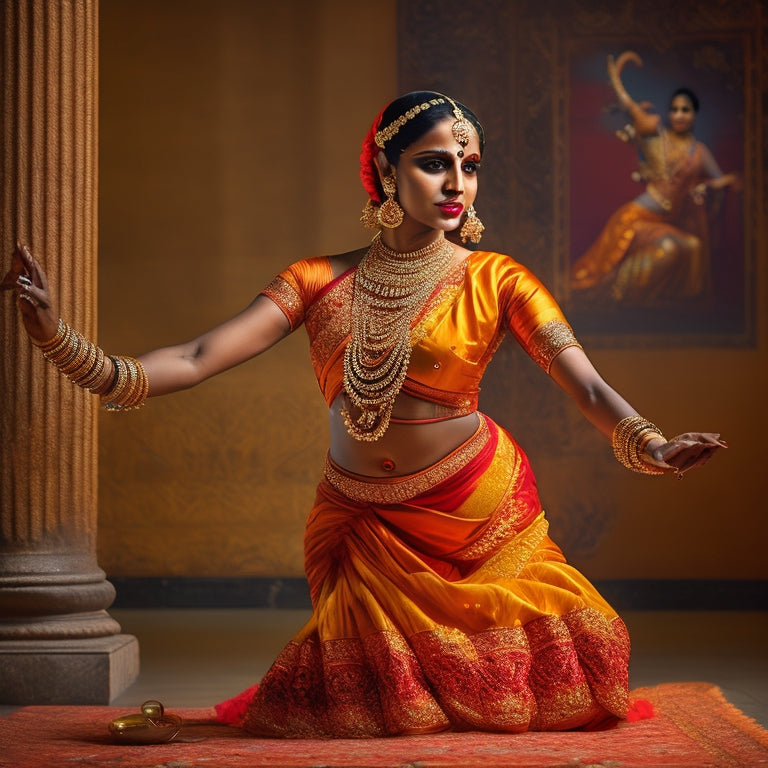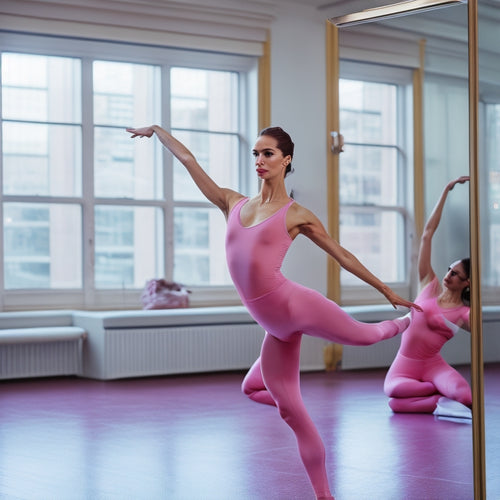
Bharatanatyam: A Rich Cultural Dance Tradition
Share
Bharatanatyam, a revered Indian classical dance form, boasts a rich cultural heritage rooted in Hindu mythology and folklore, with a history that originated in Tamil Nadu and continues to thrive as a vibrant tradition of storytelling through movement. This intricate dance style conveys emotions and themes, showcasing artistic prowess and technical mastery. From rigorous training under a guru to meticulous performance preparation, Bharatanatyam demands dedication and passion. As we explore the transformative journey of a Bharatanatyam dancer, we discover the depth and beauty of this cultural treasure, with its nuances waiting to be unraveled.
Key Takeaways
• Bharatanatyam is a revered Indian classical dance form with origins in Tamil Nadu, steeped in Hindu mythology and folklore.
• This ancient dance tradition conveys emotions and themes through intricate storytelling, showcasing artistic prowess.
• Bharatanatyam involves rigorous training under a Guru, establishing a strong foundation for a successful career as a cultural ambassador.
• The dance form requires meticulous preparation, including costume selection, stage presence, and mental discipline, to deliver a captivating performance.
• Through years of practice and perseverance, Bharatanatyam dancers embark on a transformative journey, refining their technique and deepening their expression.
Origins and Cultural Significance
Bharatanatyam, a traditional Indian classical dance form, originated in Tamil Nadu and has a rich history and cultural significance that dates back centuries.
This dance form is an integral part of India's cultural heritage, with its roots deeply embedded in Hindu mythology and folklore. Through traditional storytelling, Bharatanatyam brings to life ancient tales of gods and goddesses, conveying emotions and themes that resonate with audiences.
The dance form's intricate movements, gestures, and expressions are a reflection of its cultural significance, showcasing the artistic prowess of Indian classical dance.
As a repository of India's rich cultural heritage, Bharatanatyam continues to captivate audiences, preserving the country's traditional storytelling legacy.
The Dance Journey Begins
Typically, a young dancer's journey into Bharatanatyam commences with parental support, which often ignites a lifelong passion for this traditional Indian classical dance form. Parental influence plays a significant part in introducing children to this vibrant cultural legacy.
As they mature, their fascination and commitment to the art form deepen, propelling them to seek rigorous training under the guidance of a Guru. This signifies the start of a lifelong dedication to mastering the complexities of Bharatanatyam.
With each passing year, the dancer's technical proficiency and artistic expression evolve, establishing the groundwork for a successful career in this classical dance form. Through unwavering training commitment, young dancers set out on a transformative journey, honing their skills, and ultimately, emerging as ambassadors of this esteemed cultural tradition.
Preparing for a Performance
As the curtains draw near, a Bharatanatyam dancer's preparation for a performance becomes a meticulous and deliberate process, involving a combination of physical, mental, and emotional discipline. Every detail is vital, from costume selection to stage presence, music coordination, and choreography adjustments.
| Pre-Performance Checklist | Key Considerations |
|---|---|
| Costume Selection | Comfort, aesthetics, and cultural significance |
| Music Coordination | Tempo, rhythm, and harmony with the dance |
| Choreography Adjustments | Refining movements, transformations, and expressions |
| Stage Presence | Confidence, poise, and audience engagement |
| Rehearsal and Visualization | Mental preparation and performance quality |
The Road to Arangatrum
Through rigorous training and unwavering dedication, a Bharatanatyam dancer begins on the transformative journey towards their Arangatrum, a milestone that showcases their artistic growth and mastery over the classical dance form.
This journey is marked by significant performance milestones, demonstrating the dancer's progress and commitment to the art. As they advance, their technique refines, and their expression deepens, reflecting their artistic growth.
The Arangatrum represents a culmination of years of practice, discipline, and perseverance, marking a significant turning point in the dancer's career. By focusing on personal growth rather than just achieving performance milestones, the dancer can truly excel in their craft, ultimately leading to a triumphant Arangatrum that celebrates their mastery of Bharatanatyam.
Showcasing Appreciation and Respect
The tradition of presenting gifts at an Arangatrum is a meaningful way to demonstrate appreciation and respect for the dancer's dedication and hard work. This gesture acknowledges the years of rigorous training, sacrifice, and perseverance that have gone into perfecting the art form. Here are some ways gift giving showcases audience support:
-
Symbolic gestures: Gifts symbolize the audience's admiration for the dancer's talent and dedication.
-
Encouragement: Thoughtful gifts motivate the performer to continue pursuing their passion.
-
Appreciation: Gifts express gratitude for the entertainment and cultural enrichment provided by the dancer.
- Bonding: The tradition of giving gifts strengthens the bond between performers and supporters, fostering a sense of community.
The Art of Makeup in Dance
Precision is essential in the art of makeup for classical dance, where a flawless base lays the foundation for a mesmerizing performance. A well-executed makeup look enhances the dancer's stage presence and brings out the emotional depth of the performance. In Bharatanatyam, makeup techniques involve a delicate balance of highlighting and contouring to accentuate the facial features. Cosmetics selection is pivotal, as it affects the durability and appearance of the makeup.
| Makeup Aspect | Technique | Cosmetic Selection |
|---|---|---|
| Base | Foundation or Pancake | Choose a base that suits skin type and tone |
| Eye Definition | Liner and Shadow | Select shades that complement the costume |
| Lip Color | Natural Shades | Opt for a lip color that complements the overall look |
Mastering the Dance Form
A Bharatanatyam dancer's mastery of the dance form is contingent upon their ability to harmoniously integrate intricate footwork, nuanced hand gestures, and expressive facial movements. To achieve this, dancers must focus on refining their performance techniques, including:
-
Traditional attire: Adorning themselves in traditional Bharatanatyam costumes, complete with intricate jewelry and ornate headdresses, to enhance their stage presence.
-
Musical accompaniment: Developing a deep understanding of the accompanying music, including the rhythms, melodies, and lyrics, to inform their movements.
-
Stage presence: Cultivating a strong, confident stage presence through deliberate practice and performance experience.
- In-depth knowledge: Acquiring a deep understanding of Bharatanatyam's rich cultural heritage, including its history, mythology, and symbolism, to bring authenticity and depth to their performances.
Frequently Asked Questions
What Is the Ideal Age to Start Learning Bharatanatyam?
The ideal age to start learning Bharatanatyam varies, but early childhood (ages 5-7) is best for developing muscle memory and technique. Teenage years (13-19) are suitable for refining skills, while adult beginners and senior learners can still benefit from dedicated practice and guidance.
Can Bharatanatyam Be Learned Without a Guru's Guidance?
While self-learning and online classes can provide foundational knowledge, they lack personalized feedback and correction, making it challenging to master Bharatanatyam's intricate techniques and nuances, emphasizing the importance of guidance from a qualified Guru.
Are There Any Physical Limitations for Learning Bharatanatyam?
While physical limitations, such as flexibility or mobility issues, may impact Bharatanatyam learning, mental barriers, like self-doubt or fear, can be more debilitating. A dedicated approach and adapted training can help overcome both, ensuring inclusivity in this traditional dance form.
Can Bharatanatyam Be Performed to Modern or Contemporary Music?
While traditional Bharatanatyam is deeply rooted in classical music, the art form's versatility allows for unexpected fusions, begging the question: can modern or contemporary music serve as a canvas for this ancient dance, sparking cultural fusion opportunities?
Are There Any Opportunities for Bharatanatyam Dancers to Perform Abroad?
Global interest in Indian classical dance forms has created international performances and cultural exchange opportunities, allowing Bharatanatyam dancers to showcase their artistry abroad, fostering cross-cultural understanding and artistic growth.
Related Posts
-

Top Performance Headbands for Fitness Enthusiasts
When you're looking for top performance headbands, focus on options that combine advanced moisture-wicking fabrics wi...
-

Dance Practice Wear Picks for Maximum Comfort and Performance
When choosing dance practice wear, you want gear that optimizes comfort and performance. Opt for moisture-wicking fab...
-

Tutu Fun: Ballet Scrunchie Cards Dance Delight
Ballet enthusiasts can elevate their dance style with unique digital downloads, specifically designed ballet-inspired...


